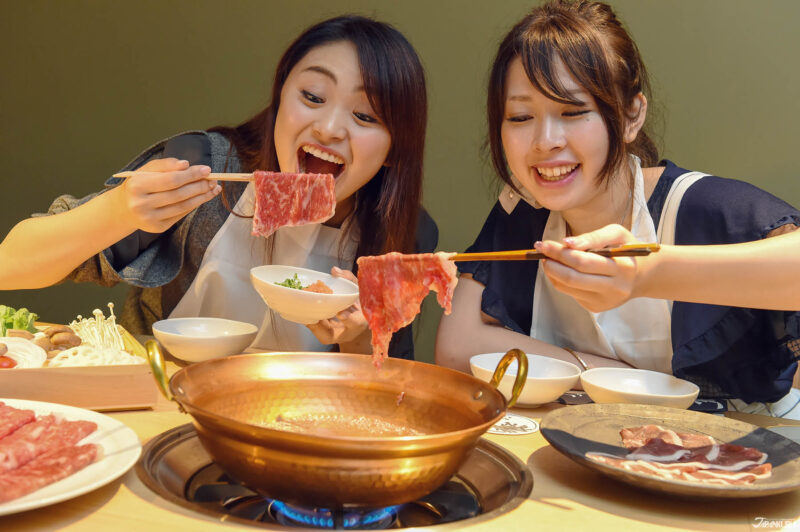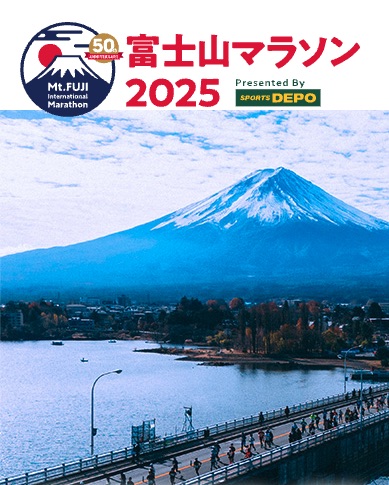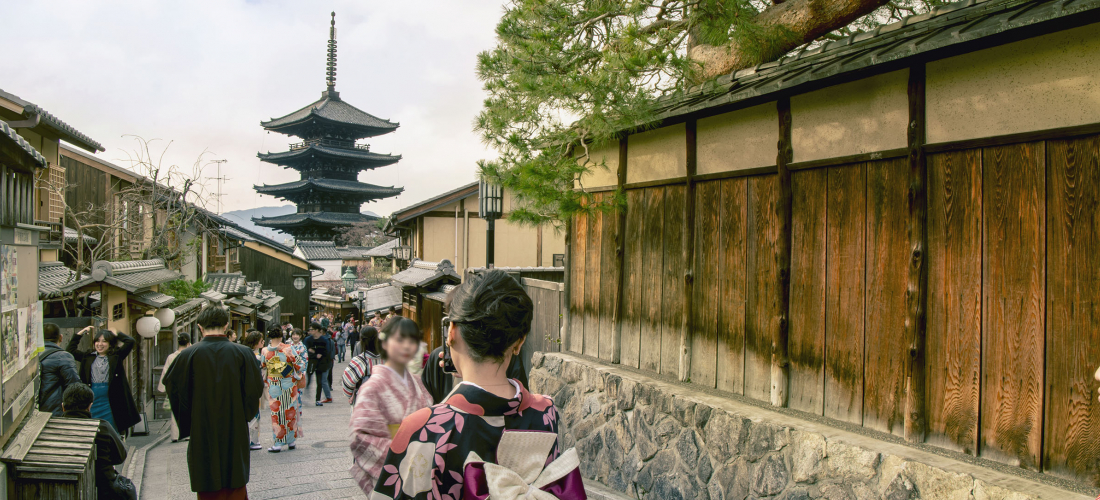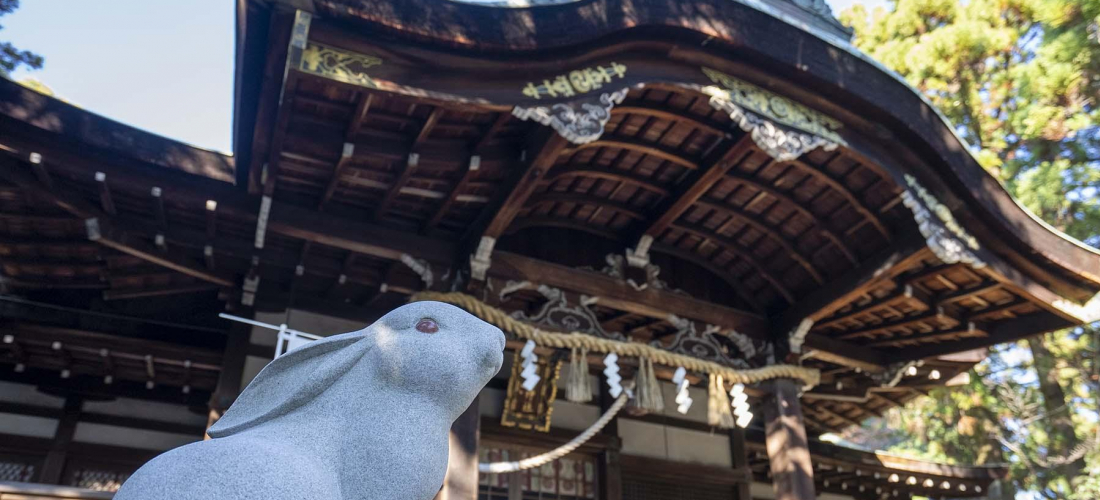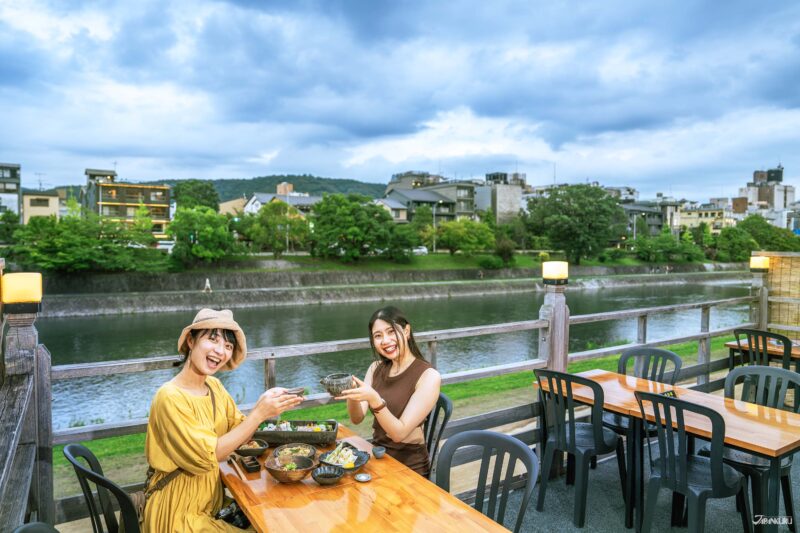
CONTENTS
A summer evening in Japan’s ancient capital of Kyoto can include many pleasures: a meal on the riverbank, a glimpse of the Gion Festival, cool moss underfoot, wind whistling through bamboo groves, and even some more modern additions like the Kyoto Aquarium. But as busy as you might find yourself seeing the sights all day in Kyoto, sometimes it can be a little hard to figure out what to do once the sun begins to set. So on our recent trip to Kyoto, the Japankuru teamed up with Japanese glasses brand JINS for their “JINS 30min Night Walk” project, making it our mission to come up with two plans for Kyoto after dark. Find out how to make the most of your night in Kyoto!
What Is a JINS 30min Night Walk?

The latest project from Japanese glasses shop JINS, each JINS 30min Night Walk is designed to help travelers enjoy their trip to Japan to the absolute fullest. Since JINS glasses can be made in as little as just 30 minutes, these “night walks” offer a little guide to seeing the sights during that 30-minute wait, so customers don’t have to waste a minute waiting around!
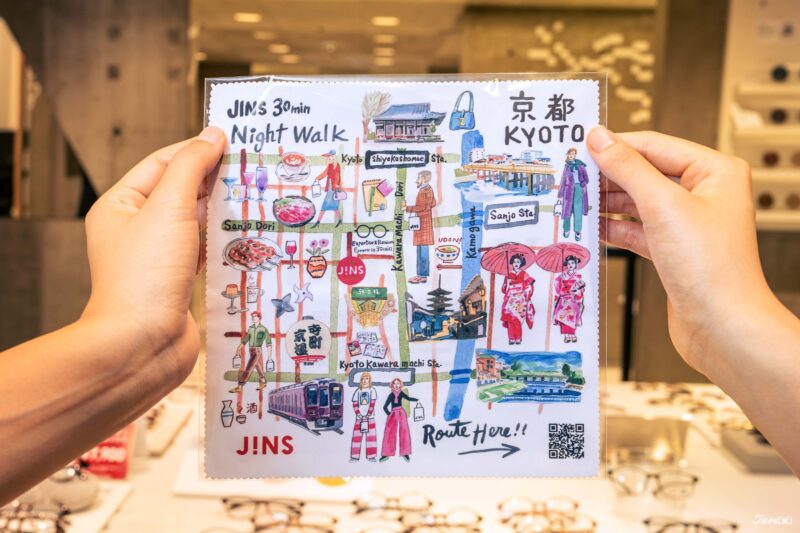
As part of the project, customers visiting from overseas who make a tax-free purchase also receive a “Night Voucher” lens cloth to use as a coupon. One side comes printed with a cute illustrated map of the area and its landmarks, and on the other side has details on how to use it as a coupon – scan the QR code to find a list of nearby shops and restaurants that will give you a discount or freebie when you show your Night Voucher! (You can also check the list of participating shops on the official website.)
If you’ve been keeping up with recent Japankuru articles, then thank you! But also, you might remember that last year we thought up a few Night Walk plans for the JINS Shibuya shop. This time, we’re heading to the JINS Kyoto Teramachi-dori shop, and we’ve got some exciting plans for how to make the most of our night in Kyoto!
First Stop: JINS Kyoto Teramachi-dori
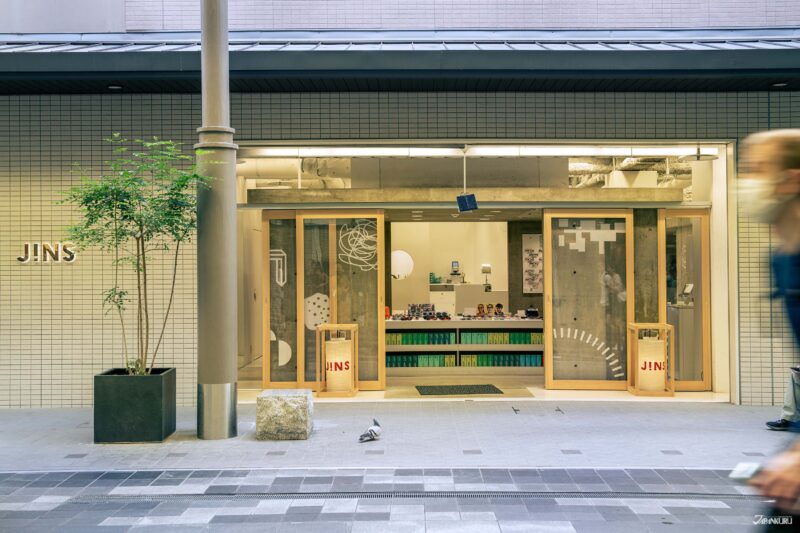
Arriving at JINS Kyoto Teramachi-dori in the afternoon, we were a little surprised and impressed by the shop’s mix of modern and traditional Japanese style, and the paper lanterns on each side of the wooden doors were particularly striking.

The building was specially designed with the image of a traditional Japanese rowhouse in mind, divided into a large main space and smaller enclaves, but constructed out of modern, minimalist concrete. With the addition of some distinctly Kyoto-esque murals on the wall, it leaves a lasting impression.
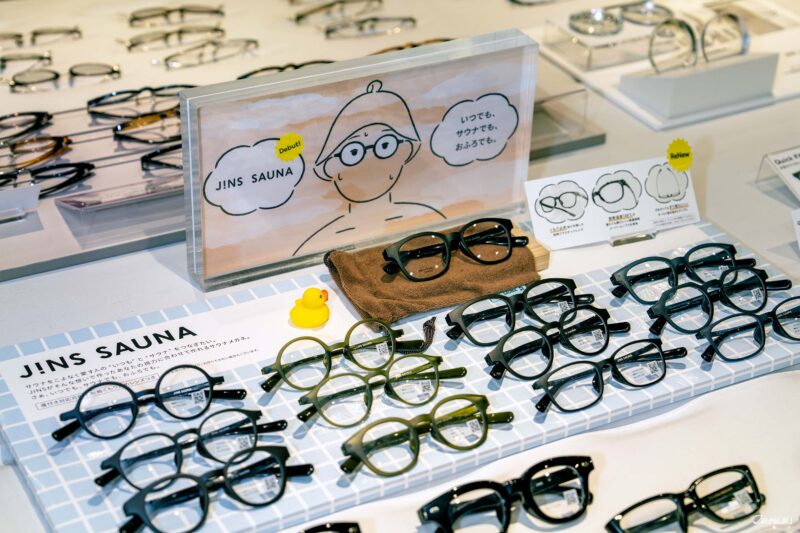



Inside the shop you’ll find the popular JINS SCREEN series with its blue light cut lenses, JINS Switch glasses with their retro (but undeniably convenient) clip-on sunglasses, the super lightweight Airframe series, the stylish frames of the JINS CLASSIC line, plus a wide variety of sunglasses, and even a number of frames designed in collaboration with other brands. On this trip to JINS, however, we were most intrigued by a few new product lines!
JINS HOME®︎: Glasses to Change Into at Home
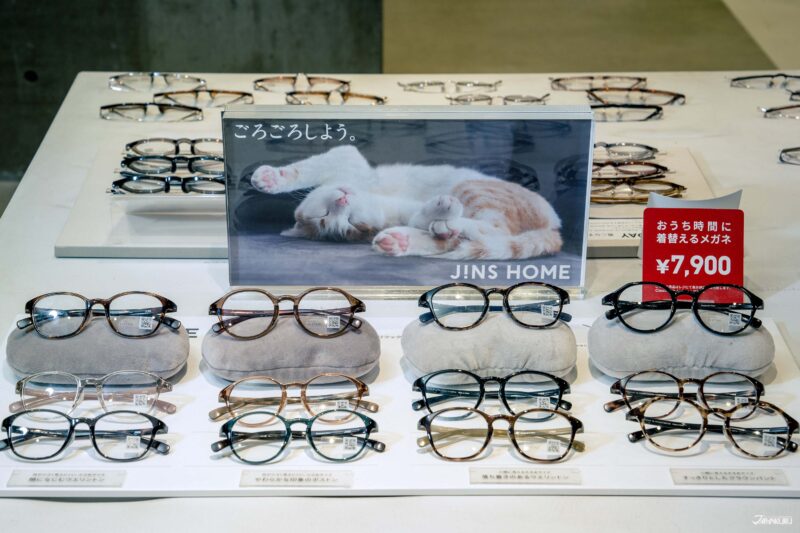
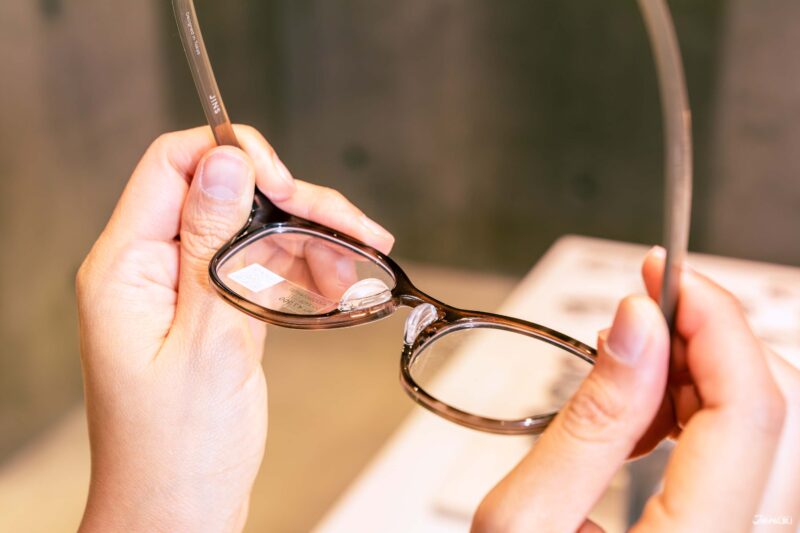
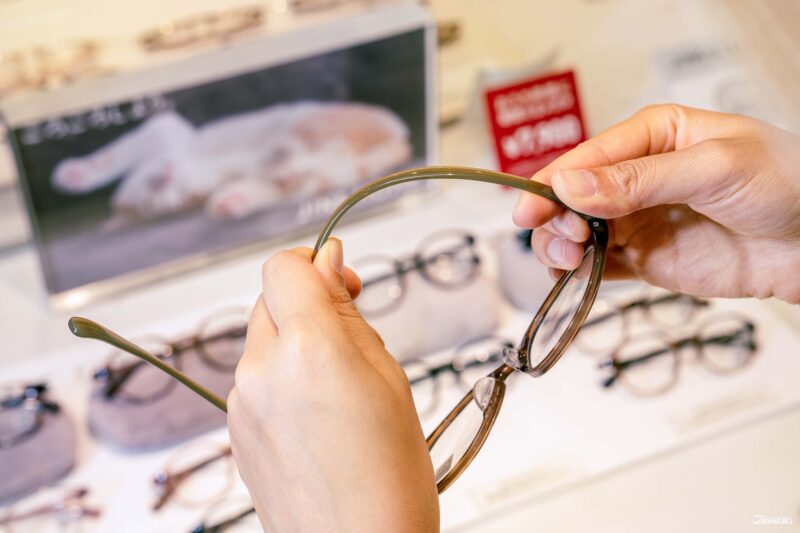
Just like you might have a cozy change of clothes waiting to relax in when you get home, these glasses are designed for spending time around the house. The flat temples on JINS HOME frames are made to reduce discomfort, and the flexible material helps them fit comfortably on heads of all shapes and sizes without poking or prodding – even when laying down and lounging around. The silicon pads also keep the pressure off your nose, even when worn all day! Between the blue light cut lenses and the sophisticated designs, they’re a great choice for working from home – stay comfortable, look good for your meeting, and keep the digital screens from affecting your sleep while you’re at it.
(It turns out JINS HOME®︎ glasses have actually been around for a few years, but after JINS started promoting them recently with pictures of some very relaxed kitty cats, they’ve been getting a lot more attention!)
JINS “Glasses That Won’t Make Your Eyes Look Small”
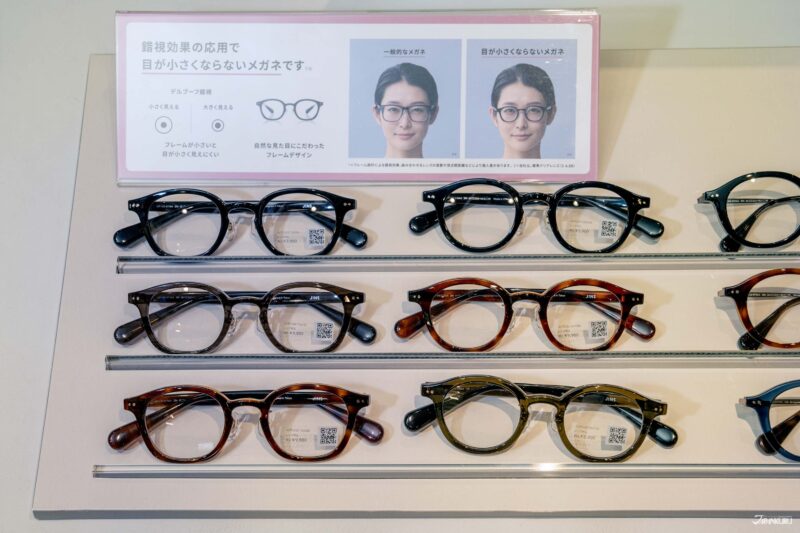
If your strong glasses prescription has you stuck with thick lenses, then your ears might perk up just hearing the name of this product line. This new series, literally named the JINS “glasses that won’t make your eyes look small” (目が小さくならないメガネ), is actually designed to counteract the eye-shrinking effects of a strong prescription by using optical illusion. By carefully adjusting the size and shape of the glasses, fine-tuning the way they frame the eyes, shrinking the width of the lenses, and even shifting the angle of the temples, these frames help to fix a problem that many glasses wearers have been dealing with for years. This new series just arrived on shelves in July 2024 with four basic designs, but you might want to try them on and see the effects as soon as you get to Japan.
JINS Screen for Sleep

We already touched on JINS’ popular blue light cut lenses when looking at the JINS HOME series, but another collection of cute boxes decorated with sweet sleeping animals also caught our eyes at JINS Kyoto Teramachi-dori. Inside the boxes are JINS Screen for Sleep glasses, a line made to help you improve the quality of your sleep. The evidence and theories regarding the effect of blue light on the human body is a bit conflicting, and it’s possible that it affects different people to different extents, but if you’re concerned about the quality of your sleep, cutting down on blue light might be one way to improve the situation. A pair of JINS Screen for Sleep glasses might be just the thing for you.
Through joint research with academic organizations, studies found that JINS blue light cut lenses were able to cut down on blue light by 40% according to official European standards (51% according to the old British Standard), significantly weakening the effect that blue light has on the body. The glasses come in both adult and children’s sizes, and the adult glasses come in two different designs. Considering the eye-catchingly adorable box designs, they make fun gifts, even for yourself!

Once you’ve explored all the options at JINS Kyoto Teramachi-dori, found the perfect frames, and chosen the right lenses, it’s time to fill out your information using the tablet next to the counter! (Hint: sometimes there’s a little bit of a wait before you can get your vision tested, so we actually recommend filling out your information and taking a number before you pick out your frames.) The process is largely automated for convenience, but staff are around throughout the vision test and checkout to guide you through.
At checkout, show your passport and proof of entering the country within the last 6 months (a plane ticket, etc), and not only can you make your purchase tax-free, but you’ll also get your own JINS 30min Night Walk lens cloth complete with a cute illustrated map and coupon options!

Grab the pick-up slip and your lens cloth Night Voucher, and it’s time to enjoy Kyoto until your glasses are ready. Off we go!
JINS Kyoto Teramachi-dori (JINS 京都寺町通店)
406-4 Sakuranocho, Nakagyo Ward, Kyoto
Hours: 11:00 – 20:00
Official Website (jp)
Kyoto Summer Night Plan ① Refreshing Riverside Food and Fun
JINS Kyoto Teramachi-dori is surrounded by symbols of the city. One of Kyoto’s most famous geisha (or maiko) districts, called Pontocho, is less than a 10-minute walk away. And just beyond flows Kyoto’s Kamogawa River, where riverside dining on a raised “kawadoko” wooden platform is a sign of the summer. The shop is even located squarely in the middle of the festivities of one of Japan’s Three Great Festivals – Kyoto’s Gion Festival, held every July. Even if you miss the festival’s famous yamaboko parade floats, you can still feel the festive atmosphere at nearby Yasaka Shrine, so let’s take a look together!
① Shiki Yoshina Pontocho

If you love Kyoto’s cultural traditions, you might already know about the Gion Festival, and even about the city’s riverside dining. But how familiar are you with Kyoto’s conger eel cuisine? Called “hamo” (ハモ) in Japanese, this special summer delicacy is a local favorite, so we decided to give it a try at Shiki Yoshina Pontocho, a restaurant with a fusion of Western and traditional Japanese cuisine, where you can eat by the riverside or even book a traditional Kyoto banquet with maiko (Kyoto’s geisha)!

Of course, the restaurant’s conger eel alone makes it worth a visit, served up as sashimi, tempura, or “nanbanzuke” in a spicy sauce. There’s nothing like enjoying a delicious meal of local delicacies while enjoying the breezy riverside veranda, and watching the sun as it sets over the Kamogawa River.
Shiki Yoshina Pontocho (先斗町 四季 よし菜)
141-1 Wakamatsucho, Nakagyo Ward, Kyoto
Hours: 17:00 – 22:30 (last order 22:00)
Directions: 5 min from Sanjo Keihan Station, or 10 min from Kyoto-Kawaramachi Station
Official Website (jp) | Reservations
② From Sanjo Bridge, Along the Kamogawa River
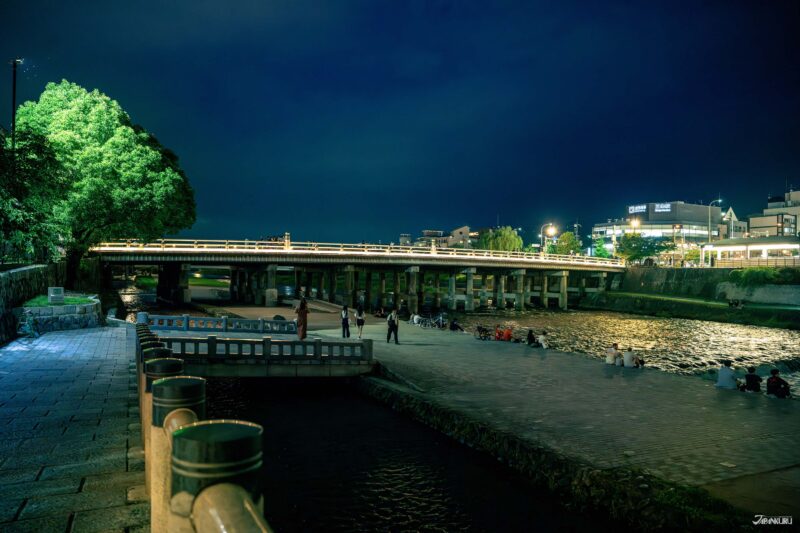
Once you’re finished eating and the sun has set, it’s time to set off along the river to enjoy the cool breeze along the water, the lights glowing on Sanjo Bridge (sometimes called “Sanjo Ohashi”), and the convivial atmosphere. This part of the riverbank is a popular gathering spot, especially on warm summer evenings, so you’ll be joined by plenty of others out enjoying the night – strolling at a leisurely pace, sitting by the water and chatting, or jogging along the gravel paths.

Head over the bridge and cross the river to enter the Gion Shirakawa area. Make sure to turn back for a moment once you reach the opposite bank – the view of glowing kawadoko platforms across the water is almost magical.
Sanjo Bridge (三条大橋)
Ohashicho, Higashiyama Ward, Kyoto
③ Gion Shirakawa
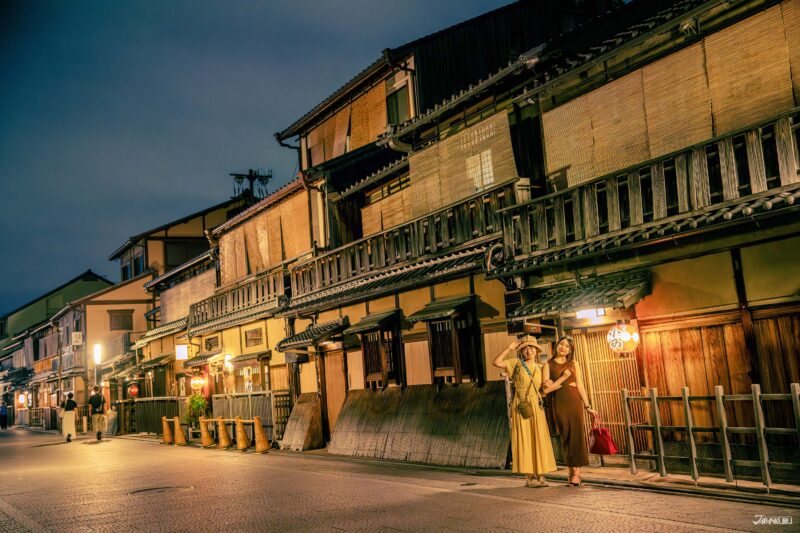
Gion is already known as Kyoto’s most famous maiko district, and the Shirakawa section is particularly iconic thanks to the old traditional buildings and cobbled streets that line the tiny Shirakawa River. During the spring, the beautiful cherry blossoms attract crowds, but the area is beautiful all year round. On a steamy summer night, with all the lanterns aglow, it feels like you’ve stepped back in time.
Gion Shirakawa (祇園白川)
Shirakawa Lane, Motoyoshicho, Higashiyama Ward, Kyoto
④ Yasaka Shrine
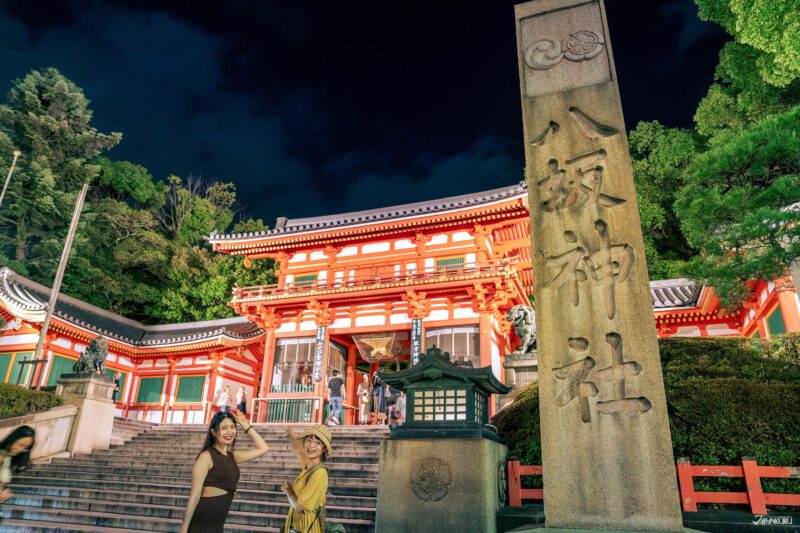
Our last stop on this Kyoto night walk is Yasaka Shrine, a landmark in the Gion neighborhood, and the very heart of Kyoto’s renowned Gion Festival. The shrine is lit up with rows and rows of glowing paper lanterns, so even if you miss the festival, you can still enjoy a little of the festive atmosphere.

Even without the ostentatious elegance of the yamaboko parade floats around, every night at Yasaka Shrine feels like a festival!
Yasaka Shrine (八坂神社)
625 Gionmachi Kitagawa, Higashiyama Ward, Kyoto
Directions: 5 min from Gion-Shijo Station or 8 min from Kawaramachi Station
Official Website (en)
Kyoto Summer Night Plan ② Food and Drinks Along the Shopping Street
JINS Kyoto Teramachi-dori is located on the busy Teramachi Kyogoku Shopping Street, a covered pedestrian shopping arcade in the middle of the city with retro vibes and a fun, bustling atmosphere. The street has been a center of commerce in Kyoto for hundreds of years, but these days you’ll find a modern mix of shops including plenty of vintage clothing stores and Kyoto-esque restaurants. Whether you just want to grab a bite to eat before enjoying an evening walk in the area, or you’re hungry enough to go from one eatery to another, we’ve got three spots along Teramachi Street for you to sit down and dig in!
① Kyogoku Stand

Teramachi Kyogoku Shopping Street is actually Y-shaped, with Teramachi Street running straight through the city for a number of blocks, and the smaller Shin-Kyogoku street branching off halfway. Our first stop is actually along this sister street, as we head to Kyogoku Stand, a historic izakaya that was first established almost a hundred years ago. The restaurant’s old-fashioned interior recalls decades of cheerful meals shared with friends, and seating options include both individual tables, and also a large counter that might feel a little more approachable for solo diners. You might even make some new friends while you eat!
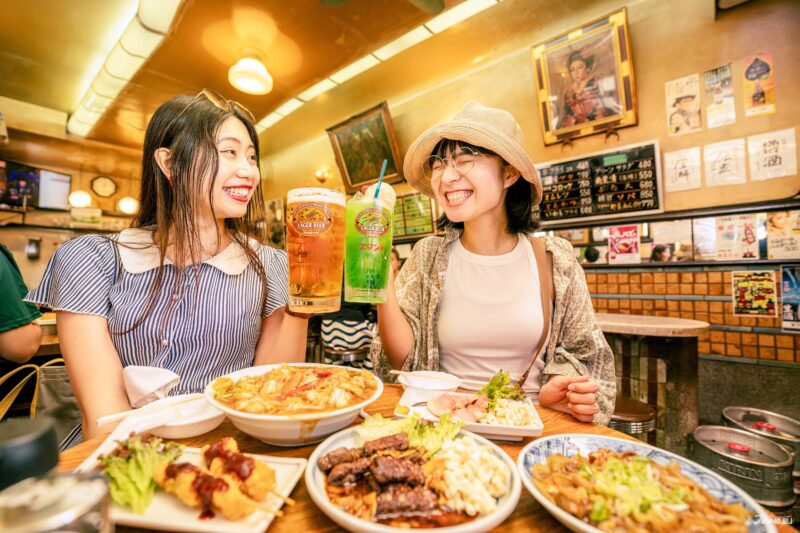
Kyogoku Stand opens at noon, and the menu has a pretty large variety of options, from lighter snacks to heartier meals like ramen and Japanese-Western yoshoku classics. It’s a convenient place to stop in, whether you want to grab lunch, a place to sit and wait while your travel companions are shopping, or some good drinks and food in the evening. With a full drink menu and popular dishes like agesoba, ramen, oden, and rice bowls topped with omelette and demiglace sauce, it’s worth a visit.
Kyogoku Stand (京極スタンド)
546 Nakanocho, Nakagyo Ward, Kyoto
Hours: 12:00 – 21:00
Directions: just outside exit 9 of Kawaramachi Station, 8 min from Shijo Station, 10 min from Karasuma Station, or just next to Shijo-Kawaramachi bus stop
Official Website (jp)
② Sala Obanzai & Grill
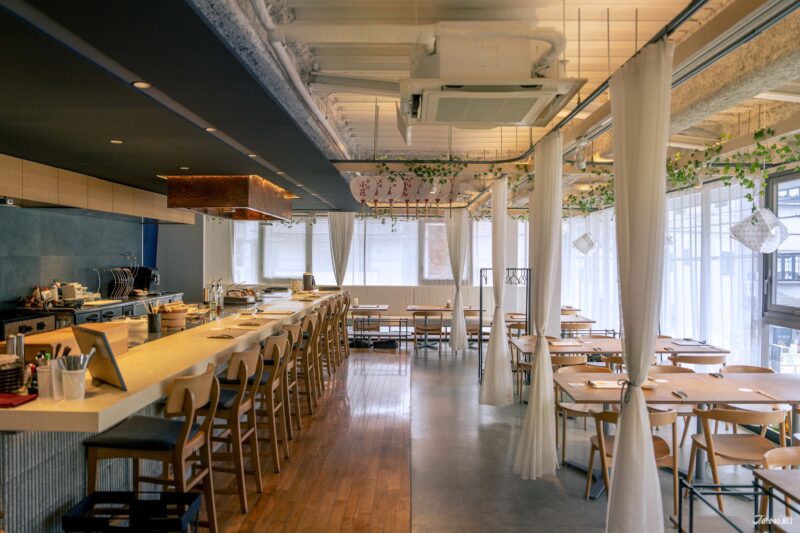
If you’re in Kyoto with the aim of enjoying local food, it doesn’t get much more “Kyoto” than a meal of “obanzai.” This colorful cuisine is a local creation focused on simple Kyoto produce, and it’s still found on dinner tables across Kyoto, but you can try it not far from Teramachi at Sala Obanzai & Grill. This spacious second-floor restaurant has a modern feel, but the focus is on obanzai and teppan grilled meals, and the open kitchen gives you a clear view of how all the local dishes are prepared. (Although if you’d prefer a little privacy instead, they offer private spaces as well.
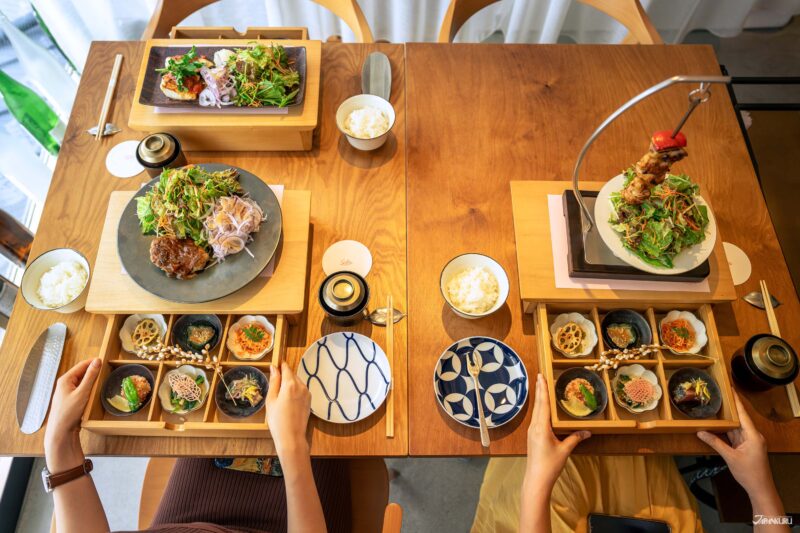
As you might guess from the restaurant’s name, the menu offers Japanese food with a little Western inspiration, and the lunch menu has a selection of sets and platters with both obanzai cuisine and teppan grilled dishes for a balanced mix of meat and vegetables. Dinner is generally a la carte, but you can also opt for the omakase menu, and leave it up to the chef!
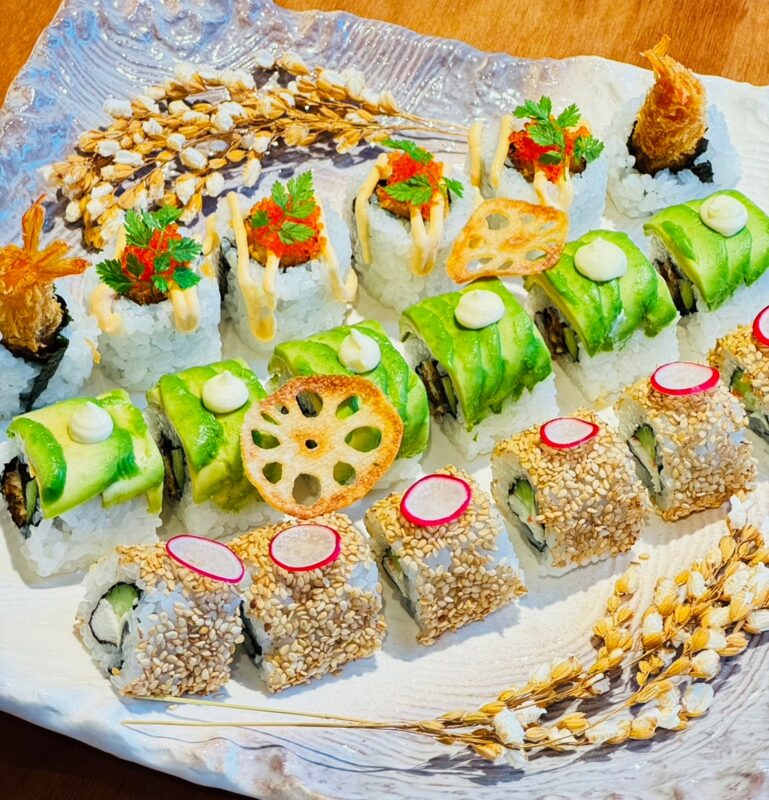
Image Courtesy of Sala Obanzai & Grill
The restaurant’s interior may seem simple, but if you look closely there’s a strong emphasis placed on local Kyoto ceramics! Look out for the beautiful Kyoto pottery used for plating many of the dishes, and even the ceramic sink in the bathroom, made by a Kyoto artisan!
Also, don’t forget to show your Night Voucher to the staff when you order, for a free drink with your meal!
Sala Obanzai & Grill (おばんざいとグリル SALA 四条河原町)
329 Tabiyacho, Shimogyo Ward, Kyoto
Hours:
Lunch: 11:00 – 14:30 (last order 14:00)
Weekday Dinner: 18:00 – 22:00 (last order 21:30)
Weekend/Holiday Dinner: 17:00 – 22:00 (last order 21:30)
(closed Mondays)
Directions: 2 min from Kyoto-Kawaramachi Station, 5 min from Karasuma Station, 8 min from Gion-Shijo Station
Official Website (jp)
③ Cafe le Gabor
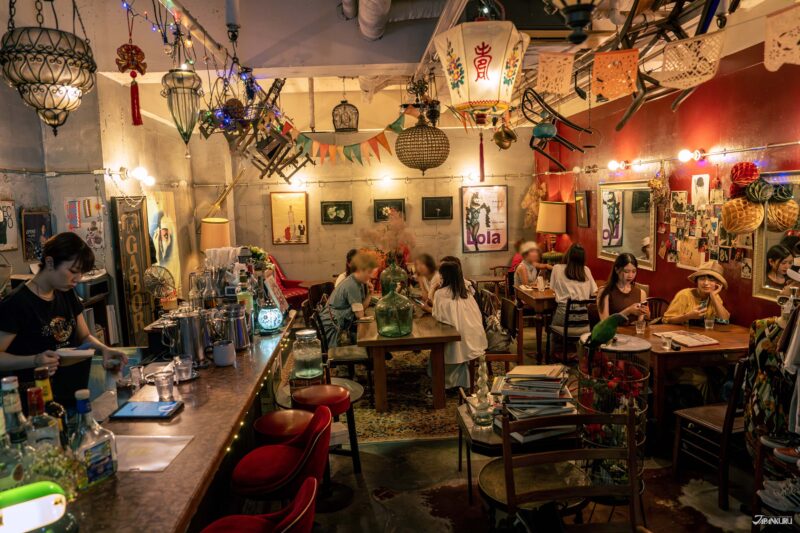
If you follow the kind of social media accounts that go looking for cute Japanese cafes, you might have seen Cafe la Madrague, in Kyoto’s Nijo area, popping up recently. But on this trip, the Japankuru team decided to check out its sister shop instead, Cafe le Gabor (often just called Gabor). Open until 11 at night, and conveniently located between Teramachi and the Kamogawa River, this “night cafe” is the perfect way to enjoy Kyoto late into the evening.
Located down a flight of stairs in a basement, it feels a little like you’re entering a cool jazz club, and the atmosphere of the shop itself is appropriately enigmatic. Old movie posters grace the walls, and if you look up, wooden chairs dangle overhead.
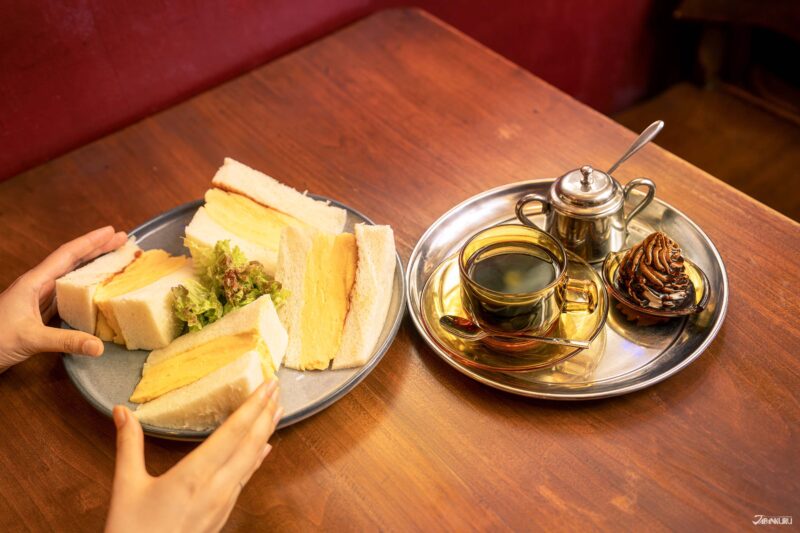
The most popular order at Cafe le Gabor is the Corona Egg Sandwich, which, at first glance, looks quite a bit like the egg sandwich served over at Cafe la Madrague. It turns out that both sandwiches are successors to the egg sandwich once served at the (now shuttered) cafe Corona, once a beloved Kyoto establishment. Over at la Madrague they’ve really mixed things up and added some twists to the sandwich, but at le Gabor they hew more closely to the Corona original, focusing on the soft fluffy eggs with red wine and mustard sauces. On Cafe le Gabor’s menu in Japanese, the sandwich’s name includes the term “元味,” or “original flavor.”
Cafe le Gabor (喫茶ガボール)
103 Nakajimacho, Nakagyo Ward, Kyoto
Hours:
Weekdays: 15:00 – 23:00 (last order 22:30)
Weekends/Holidays: 12:00 – 22:00 (last order 21:30)
Directions: 4 min from Sanjo Keihan Station
Official Website (jp)
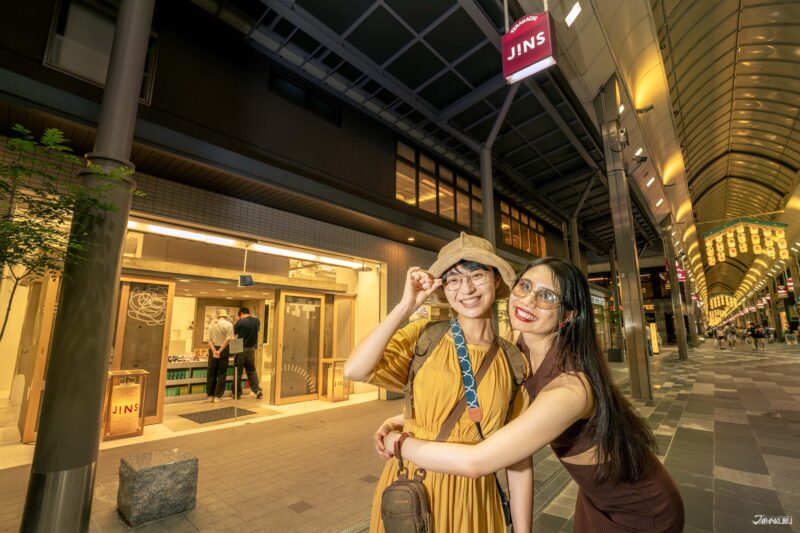
Out of the two Night Walks designed by the Japankuru team, which was more up your alley? If the answer is “both,” then you can always combine the two as well! Just don’t forget, while you’re out having fun and enjoying the night in Kyoto, to head back to JINS by 8 pm to pick up your new glasses!
Bonus: For Kyoto Accommodations, We Recommend Oriental Hotel Kyoto Rokujo

During this visit to Kyoto, the Japankuru team finished off the evening with a prayer at Yasaka Shrine and a visit to JINS to pick up our glasses, and we finally headed back to our hotel – Oriental Hotel Kyoto Rokujo. The hotel’s interior design is inspired by the traditional paths that lead to Japanese teahouses, but upon arrival we were most excited about the “welcome drink” and snack. We were impressed by the spacious size of our twin rooms, with two single beds and even a sofa to relax on.

The breakfast buffet includes some interesting options, like udon, Japanese curry, and plenty of little side dishes made with Kyoto produce. They even include traditional Japanese wafer sweets called “monaka,” and you can add your own fillings like red bean. With a breakfast like this, you’ll be well-equipped for another busy day sightseeing in Kyoto.
Oriental Hotel Kyoto Rokujo (オリエンタルホテル京都六条)
181 Bokumikanabutsucho, Shimogyo Ward, Kyoto
Check-in/Check-out: 15:00~ / ~11:00
Official Website (en) | Reservations
See Kyoto Clearly With Your New Glasses
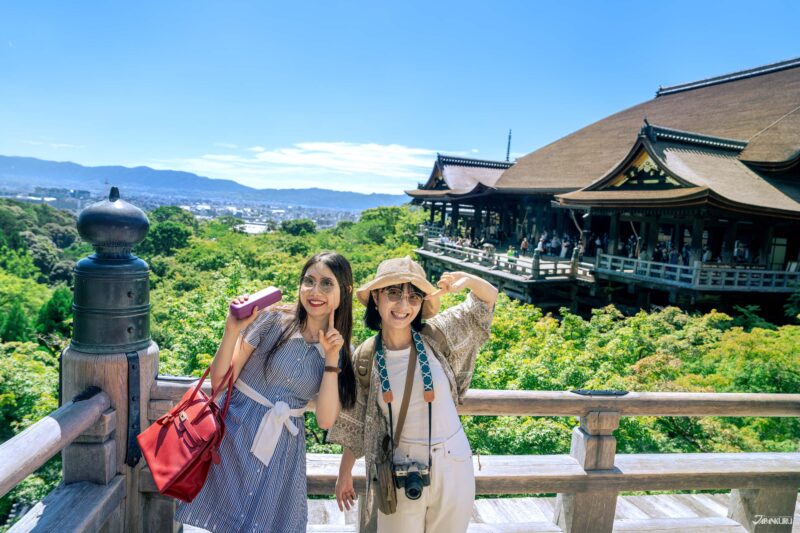
For any sightseers visiting Kyoto, a walk along Ninenzaka and Sannenzaka, followed by a trip to Kiyomizudera Temple, is basically a must – so of course the Japankuru team headed over! The area was just as busy and exciting as ever, but visiting again with new friends made the experience fresh and new. No matter how many times we visit, we always make new discoveries! Perhaps our new glasses helped us see the area in a new light.

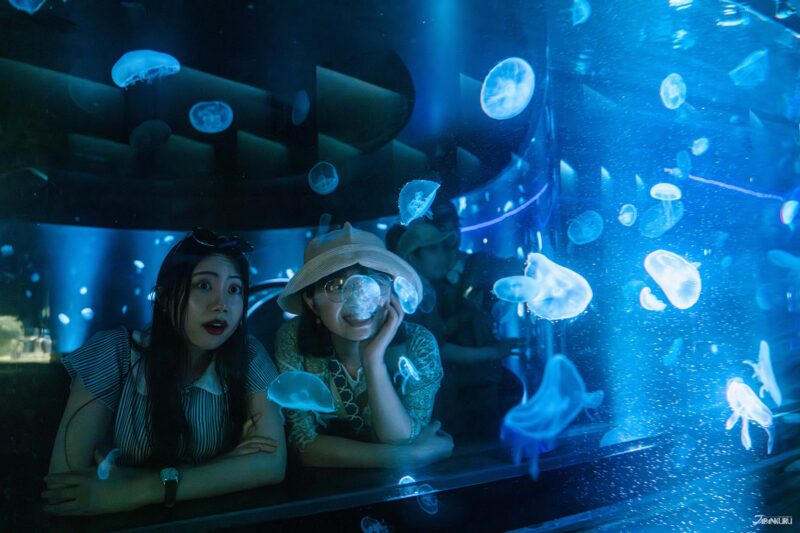
On the other hand, Kyoto locals will be the first to tell you that a Kyoto trip in summer is something of an ordeal. If you just can’t take the heat and humidity anymore, then a visit to the Kyoto Aquarium is a sensible choice! Not far from Kyoto Station, this aquarium is run by the same people as Sumida Aquarium next to Tokyo Skytree. The aquarium has always had an appealingly mysterious atmosphere, and pandemic-era renovations, a new giant 360° jellyfish tank adds to the whimsy.

Kyoto Aquarium also has a special exhibition going on just for the summer featuring adorable jellyfish-shaped windchimes and hand-painted artisan umbrellas, called “Jellyfish & Umbrellas & Windchimes” (くらげと傘と風鈴と). The Kyoto atmosphere is magnified by the summery sound of twinkling windchimes, and at night the area is lit up for extra romance. Check it out before the end of September if you’re interested!
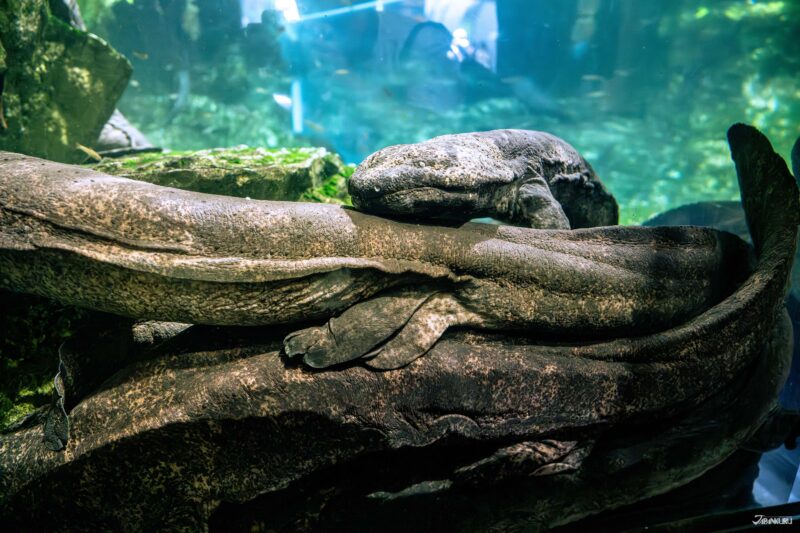
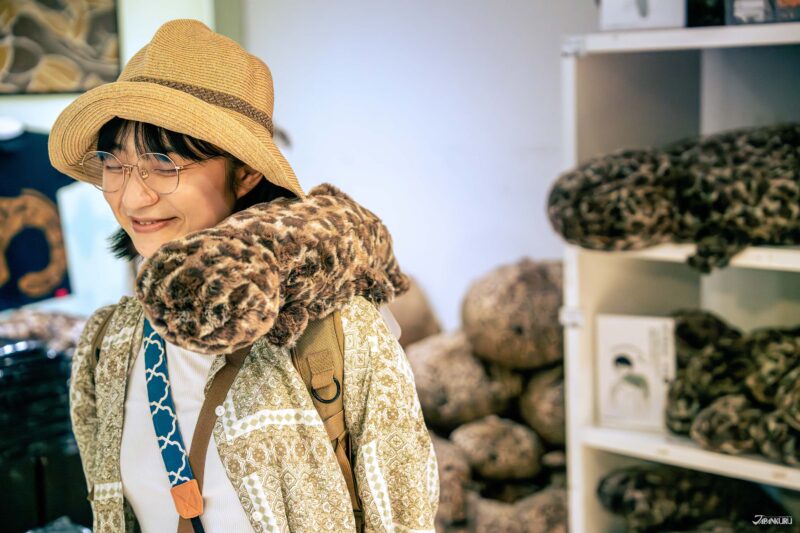
Fans of the Kyoto Aquarium will tell you that the true star of the show is actually a cute Kyoto local, an amphibian sometimes found swimming wild in the Kamogawa River, called the Japanese giant salamander. As a prime example of Japan’s obsession with creepy-cute, Kyoto Aquarium’s craggy giant salamanders are a huge hit, and not only can you see the animals hanging out in their own tank, but the gift shop offers a pretty impressive selection of cute Japanese giant salamander merchandise too. (They’ve even teamed up with a local hotel in the past to offer a Japanese giant salamander suite.) If you’re the kind of person who gets tempted by all the cute goodies in aquarium gift shops, you definitely won’t want to miss out on this one.

Along with Japanese giant salamanders and jellyfish, Kyoto Aquarium also offers popular dolphin programs, where the summer heat might just have you wishing you could join the dolphins as they leap in and out of the cool water.
Kyoto Aquarium (京都水族館)
35-1 Kankijicho, Shimogyo Ward, Kyoto
Hours:
Weekdays: 10:00 – 18:00
Weekends/Holidays: 9:00 – 19:00
*Hours sometimes extended ~20:00. See the official website for details.https://www.kyoto-aquarium.com/img/about/pdf_calender2024.pdf
Directions: 15 min from Kyoto Station’s central exit, 7 min from Umekoji-Kyotonishi Station
Official Website (en)
Which Plan Will You Choose for Summer Sightseeing in Kyoto?
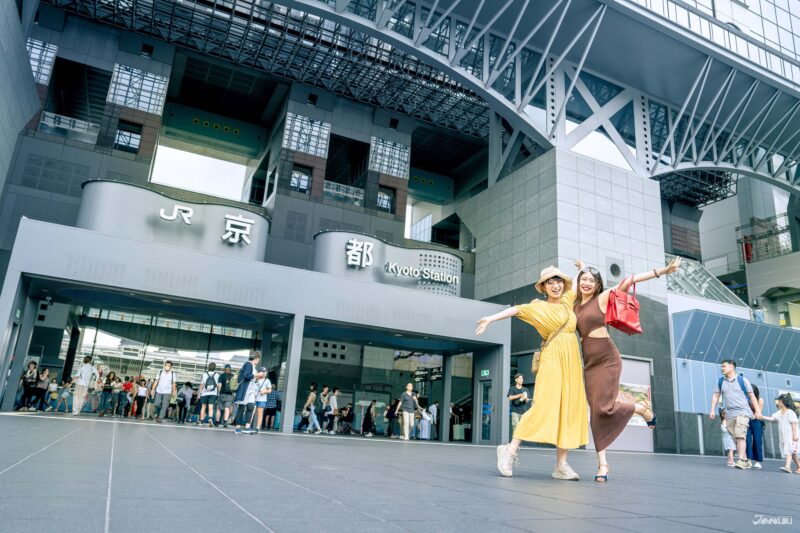
There’s a reason why Kyoto is such a standard sightseeing destination for both foreign travelers and locals in Japan. Japan’s ancient capital is packed with things to do, from history to amazing local cuisine, and of course cute cafes and great glasses! On this trip to Kyoto with JINS, we put together two plans for making the most of your evening out in Kyoto, and even tacked on some daytime sightseeing recommendations as well, but there’s still plenty more to see. What will you do on your next trip to Kyoto? Let us know, we’d love to hear!
Just remember, if you’re traveling in summer, drink plenty of water and stay in the shade when you can. It’s hot out there!
For more info and updates from Japan, check Japankuru for new articles, and don’t forget to follow us on X (Twitter), Instagram, and Facebook!
COMMENT
FEATURED MEDIA
VIEW MORE 
A New Tokyo Animal Destination: Relax & Learn About the World’s Animals in Japan
#pr #japankuru #anitouch #anitouchtokyodome #capybara #capybaracafe #animalcafe #tokyotrip #japantrip #카피바라 #애니터치 #아이와가볼만한곳 #도쿄여행 #가족여행 #東京旅遊 #東京親子景點 #日本動物互動體驗 #水豚泡澡 #東京巨蛋城 #เที่ยวญี่ปุ่น2025 #ที่เที่ยวครอบครัว #สวนสัตว์ในร่ม #TokyoDomeCity #anitouchtokyodome

Shohei Ohtani Collab Developed Products & Other Japanese Drugstore Recommendations From Kowa
#pr #japankuru
#kowa #syncronkowa #japanshopping #preworkout #postworkout #tokyoshopping #japantrip #일본쇼핑 #일본이온음료 #오타니 #오타니쇼헤이 #코와 #興和 #日本必買 #日本旅遊 #運動補充能量 #運動飲品 #ช้อปปิ้งญี่ปุ่น #เครื่องดื่มออกกำลังกาย #นักกีฬา #ผลิตภัณฑ์ญี่ปุ่น #อาหารเสริมญี่ปุ่น

도쿄 근교 당일치기 여행 추천! 작은 에도라 불리는 ‘가와고에’
세이부 ‘가와고에 패스(디지털)’ 하나면 편리하게 이동 + 가성비까지 완벽하게! 필름카메라 감성 가득한 레트로 거리 길거리 먹방부터 귀여움 끝판왕 핫플&포토 스폿까지 총집합!
Looking for day trips from Tokyo? Try Kawagoe, AKA Little Edo!
Use the SEIBU KAWAGOE PASS (Digital) for easy, affordable transportation!
Check out the historic streets of Kawagoe for some great street food and plenty of picturesque retro photo ops.
#pr #japankuru #도쿄근교여행 #가와고에 #가와고에패스 #세이부패스 #기모노체험 #가와고에여행 #도쿄여행코스 #도쿄근교당일치기 #세이부가와고에패스
#tokyotrip #kawagoe #tokyodaytrip #seibukawagoepass #kimono #japantrip

Hirakata Park, Osaka: Enjoy the Classic Japanese Theme Park Experience!
#pr #japankuru #hirakatapark #amusementpark #japantrip #osakatrip #familytrip #rollercoaster #retrôvibes #枚方公園 #大阪旅遊 #關西私房景點 #日本親子旅行 #日本遊樂園 #木造雲霄飛車 #히라카타파크 #สวนสนุกฮิราคาตะพาร์ค

🍵Love Matcha? Upgrade Your Matcha Experience With Tsujiri!
・160년 전통 일본 말차 브랜드 츠지리에서 말차 덕후들이 픽한 인기템만 골라봤어요
・抹茶控的天堂!甜點、餅乾、飲品一次滿足,連伴手禮都幫你列好清單了
・ส่องมัทฉะสุดฮิต พร้อมพาเที่ยวร้านดังในอุจิ เกียวโต
#pr #japankuru #matcha #matchalover #uji #kyoto #japantrip #ujimatcha #matchalatte #matchasweets #tsujiri #말차 #말차덕후 #츠지리 #교토여행 #말차라떼 #辻利抹茶 #抹茶控 #日本抹茶 #宇治 #宇治抹茶 #日本伴手禮 #抹茶拿鐵 #抹茶甜點 #มัทฉะ #ของฝากญี่ปุ่น #ชาเขียวญี่ปุ่น #ซึจิริ #เกียวโต

・What Is Nenaito? And How Does This Sleep Care Supplement Work?
・你的睡眠保健品——認識「睡眠茶氨酸錠」
・수면 케어 서플리먼트 ‘네나이토’란?
・ผลิตภัณฑ์เสริมอาหารดูแลการนอน “Nenaito(ネナイト)” คืออะไร?
#pr #japankuru #sleepcare #japanshopping #nenaito #sleepsupplement #asahi #睡眠茶氨酸錠 #睡眠保健 #朝日 #l茶胺酸 #日本藥妝 #日本必買 #일본쇼핑 #수면 #건강하자 #네나이토 #일본영양제 #อาหารเสริมญี่ปุ่น #ช้อปปิ้งญี่ปุ่น #ร้านขายยาญี่ปุ่น #ดูแลตัวเองก่อนนอน #อาซาฮิ

Japanese Drugstore Must-Buys! Essential Items from Hisamitsu® Pharmaceutical
#PR #japankuru #hisamitsu #salonpas #feitas #hisamitsupharmaceutical #japanshopping #tokyoshopping #traveltips #japanhaul #japantrip #japantravel

Whether you grew up with Dragon Ball or you just fell in love with Dragon Ball DAIMA, you'll like the newest JINS collab. Shop this limited-edition Dragon Ball accessory collection to find some of the best Dragon Ball merchandise in Japan!
>> Find out more at Japankuru.com! (link in bio)
#japankuru #dragonball #dragonballdaima #animecollab #japanshopping #jins #japaneseglasses #japantravel #animemerch #pr

This month, Japankuru teamed up with @official_korekoko to invite three influencers (originally from Thailand, China, and Taiwan) on a trip to Yokohama. Check out the article (in Chinese) on Japankuru.com for all of their travel tips and photography hints - and look forward to more cool collaborations coming soon!
【橫濱夜散策 x 教你怎麼拍出網美照 📸✨】
每次來日本玩,是不是都會先找旅日網紅的推薦清單?
這次,我們邀請擁有日本豐富旅遊經驗的🇹🇭泰國、🇨🇳中國、🇹🇼台灣網紅,帶你走進夜晚的橫濱!從玩樂路線到拍照技巧,教你怎麼拍出最美的夜景照。那些熟悉的景點,換個視角說不定會有新發現~快跟他們一起出發吧!
#japankuru #橫濱紅磚倉庫 #汽車道 #中華街 #yokohama #japankuru #橫濱紅磚倉庫 #汽車道 #中華街 #yokohama #yokohamaredbrickwarehouse #yokohamachinatown

If you’re a fan of Vivienne Westwood's Japanese designs, and you’re looking forward to shopping in Harajuku this summer, we’ve got important news for you. Vivienne Westwood RED LABEL Laforet Harajuku is now closed for renovations - but the grand reopening is scheduled for July!
>> Find out more at Japankuru.com! (link in bio)
#japankuru #viviennewestwood #harajuku #omotesando #viviennewestwoodredlabel #viviennewestwoodjapan #비비안웨스트우드 #오모테산도 #하라주쿠 #日本購物 #薇薇安魏斯伍德 #日本時尚 #原宿 #表參道 #japantrip #japanshopping #pr

Ready to see TeamLab in Kyoto!? At TeamLab Biovortex Kyoto, the collective is taking their acclaimed immersive art and bringing it to Japan's ancient capital. We can't wait to see it for ourselves this autumn!
>> Find out more at Japankuru.com! (link in bio)
#japankuru #teamlab #teamlabbiovortex #kyoto #kyototrip #japantravel #artnews
Photos courtesy of teamLab, Exhibition view of teamLab Biovortex Kyoto, 2025, Kyoto ® teamLab, courtesy Pace Gallery

Japanese Makeup Shopping • A Trip to Kamakura & Enoshima With Canmake’s Cool-Toned Summer Makeup
#pr #canmake #enoshima #enoden #에노시마 #캔메이크 #japanesemakeup #japanesecosmetics

⚔️The Robot Restaurant is gone, but the Samurai Restaurant is here to take its place. Check it out, and don't forget your coupon!
🍣신주쿠의 명소 로봇 레스토랑이 사무라이 레스토랑으로 부활! 절찬 쿠폰 발급중
💃18歲以上才能入場的歌舞秀,和你想的不一樣!拿好優惠券去看看~
#tokyo #shinjuku #samurairestaurant #robotrestaurant #tokyotrip #도쿄여행 #신주쿠 #사무라이레스토랑 #이색체험 #할인이벤트 #歌舞伎町 #東京景點 #武士餐廳 #日本表演 #日本文化體驗 #japankuru #japantrip #japantravel #japanlovers #japan_of_insta

Japanese appliance & electronics shopping with our KOJIMA x BicCamera coupon!
用JAPANKURU的KOJIMA x BicCamera優惠券買這些正好❤️
코지마 x 빅 카메라 쿠폰으로 일본 가전 제품 쇼핑하기
#pr #japankuru #japanshopping #kojima #biccamera #japaneseskincare #yaman #dji #osmopocket3 #skincaredevice #日本購物 #美容儀 #相機 #雅萌 #日本家電 #일본여행 #면세 #여행꿀팁 #일본쇼핑리스트 #쿠폰 #일본쇼핑 #일본브랜드 #할인 #코지마 #빅카메라 #japankurucoupon




































